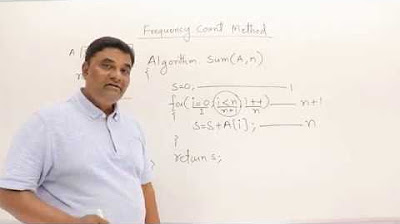Kadane's Algorithm | Maximum Subarray Sum | DSA Series by Shradha Ma'am
Summary
TLDRThe video explores the Kadane's algorithm, a dynamic programming technique for finding the maximum subarray sum in linear time (O(n)). It breaks down the steps of calculating the current and maximum sums, resetting when necessary, and discusses the underlying principles of dynamic programming, including problem decomposition. The speaker outlines a structured approach to tackle related coding problems, emphasizing prerequisites like hashing and sorting, while promising deeper dives into complex concepts later in the course. Overall, this informative session prepares viewers for common coding challenges and enhances their algorithmic understanding.
Takeaways
- 😀 Kadane's Algorithm is used to find the maximum subarray sum efficiently.
- 📈 The algorithm operates in O(n) time complexity, making it suitable for large datasets.
- 🔄 The current sum is reset to zero whenever it becomes negative, ensuring only positive contributions are considered.
- 📊 The maximum sum is updated by comparing the current sum with the previously recorded maximum sum.
- 🔍 Dynamic programming breaks down complex problems into smaller, manageable subproblems.
- 🌟 Understanding optimal substructure and overlapping subproblems is essential for mastering dynamic programming.
- 🛠️ Practical coding problems often require knowledge of algorithms like Kadane’s for efficient solutions.
- 📚 The speaker encourages learning different data structures and algorithms in a structured manner.
- 🎯 Dynamic programming concepts will be explored further in future lessons, emphasizing their importance.
- 🔗 Resources and links to further problems and materials will be provided for continued learning.
Q & A
What is the primary objective of the algorithm discussed in the video?
-The primary objective is to find the maximum sum of contiguous subarrays within a given array.
What is the time complexity of the algorithm, and why is it considered efficient?
-The time complexity is O(n), which is efficient because it processes each element of the array only once.
How does the algorithm handle negative sums during its calculation?
-If the current sum becomes negative, the algorithm resets it to zero to start calculating a new potential subarray.
What role does dynamic programming play in the algorithm?
-Dynamic programming allows the algorithm to solve the problem by breaking it into smaller, manageable subproblems, utilizing previously computed results.
Can you explain the process of updating the maximum sum in the algorithm?
-The maximum sum is updated by comparing the current sum to the existing maximum sum and taking the larger of the two.
What are the key characteristics of dynamic programming mentioned in the video?
-Key characteristics include overlapping subproblems and optimal substructure, which are essential for efficiently solving complex problems.
What types of problems are typically solved using dynamic programming?
-Dynamic programming is used for problems involving optimization and decision-making, such as knapsack problems, shortest paths, and various sequence alignment tasks.
What will be covered in future lessons related to dynamic programming?
-Future lessons will delve into more complex dynamic programming concepts, including specific algorithms and their applications in various scenarios.
How does the algorithm's approach facilitate learning and applying coding concepts?
-By applying the algorithm to real coding problems, it helps learners understand how to break down complex problems and utilize systematic approaches to arrive at solutions.
What is the significance of testing the algorithm with various cases?
-Testing with various cases ensures that the algorithm works correctly across different scenarios and helps identify edge cases that may affect its performance.
Outlines

This section is available to paid users only. Please upgrade to access this part.
Upgrade NowMindmap

This section is available to paid users only. Please upgrade to access this part.
Upgrade NowKeywords

This section is available to paid users only. Please upgrade to access this part.
Upgrade NowHighlights

This section is available to paid users only. Please upgrade to access this part.
Upgrade NowTranscripts

This section is available to paid users only. Please upgrade to access this part.
Upgrade NowBrowse More Related Video

Kadane's Algorithm | Maximum Subarray Sum | Finding and Printing

ARRAY PRACTICE PROBLEMS | Must do Array Questions | DSA Problems | GeeksforGeeks

Sliding Window in 7 minutes | LeetCode Pattern

1.4 Frequency Count Method

Time & Space Complexity - Big O Notation - DSA Course in Python Lecture 1

Python Programming Practice: LeetCode #1 -- Two Sum
5.0 / 5 (0 votes)